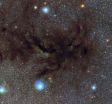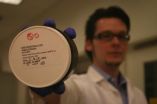(Press-News.org) The Pipe Nebula is a prime example of a dark nebula. Originally, astronomers believed these were areas in space where there were no stars. But it was later discovered that dark nebulae actually consist of clouds of interstellar dust so thick it can block out the light from the stars beyond. The Pipe Nebula appears silhouetted against the rich star clouds close to the centre of the Milky Way in the constellation of Ophiuchus (The Serpent Bearer).
Barnard 59 forms the mouthpiece of the Pipe Nebula [1] and is the subject of this new image from the Wide Field Imager on the MPG/ESO 2.2-metre telescope. This strange and complex dark nebula lies about 600-700 light-years away from Earth.
The nebula is named after the American astronomer Edward Emerson Barnard who was the first to systematically record dark nebulae using long-exposure photography and one of those who recognised their dusty nature. Barnard catalogued a total of 370 dark nebulae all over the sky. A self-made man, he bought his first house with the prize money from discovering several comets. Barnard was an extraordinary observer with exceptional eyesight who made contributions in many fields of astronomy in the late 19th and early 20th century.
At first glance, your attention is most likely drawn to the centre of the image where dark twisting clouds look a little like the legs of a vast spider stretched across a web of stars. However, after a few moments you will begin to notice several finer details. Foggy, smoky shapes in the middle of the darkness are lit up by new stars that are forming. Star formation is common within regions that contain dense, molecular clouds, such as in dark nebulae. The dust and gas will clump together under the influence of gravity and more and more material will be attracted until the star is formed. However, compared to similar regions, the Barnard 59 region is undergoing relatively little star formation and still has a great deal of dust.
If you look carefully you may also be able to spot more than a dozen tiny blue, green and red strips scattered across the picture. These are asteroids, chunks of rock and metal a few kilometres across that are orbiting the Sun. The majority lie in the asteroid belt between the orbits of Mars and Jupiter. Barnard 59 is about ten million times further away from the Earth than these tiny objects [2].
And finally, as you take in this richly textured tapestry of celestial objects, consider for a moment that when you look up at this region of sky from Earth you would be able to fit this entire image under your thumb held at arms-length despite it being about six light-years across at the distance of Barnard 59.
INFORMATION:
Notes
[1] The entire Pipe Nebula is comprised of Barnard 65, 66, 67 and 78, in addition to Barnard 59. It can be seen easily with the unaided eye under dark and clear skies and is best spotted from southern latitudes where it appears higher in the sky.
[2] Asteroids move during the exposures and create short trails. As this picture was created from several images taken in different colours at different times the different colour trails are also shifted relative to each other.
More information
The year 2012 marks the 50th anniversary of the founding of the European Southern Observatory (ESO). ESO is the foremost intergovernmental astronomy organisation in Europe and the world's most productive ground-based astronomical observatory by far. It is supported by 15 countries: Austria, Belgium, Brazil, the Czech Republic, Denmark, France, Finland, Germany, Italy, the Netherlands, Portugal, Spain, Sweden, Switzerland and the United Kingdom. ESO carries out an ambitious programme focused on the design, construction and operation of powerful ground-based observing facilities enabling astronomers to make important scientific discoveries. ESO also plays a leading role in promoting and organising cooperation in astronomical research. ESO operates three unique world-class observing sites in Chile: La Silla, Paranal and Chajnantor. At Paranal, ESO operates the Very Large Telescope, the world's most advanced visible-light astronomical observatory and two survey telescopes. VISTA works in the infrared and is the world's largest survey telescope and the VLT Survey Telescope is the largest telescope designed to exclusively survey the skies in visible light. ESO is the European partner of a revolutionary astronomical telescope ALMA, the largest astronomical project in existence. ESO is currently planning a 40-metre-class European Extremely Large optical/near-infrared Telescope, the E-ELT, which will become "the world's biggest eye on the sky".
Links
- Photos of the MPG/ESO 2.2-metre Telescope: http://www.eso.org/public/images/archive/search/?adv=&subject_name=mpg
- Other photos taken with the MPG/ESO 2.2-metre Telescope: http://www.eso.org/public/images/archive/search/?adv=&facility=15
- Photos of La Silla: http://www.eso.org/public/images/archive/category/lasilla/
Contacts
Richard Hook
ESO, La Silla, Paranal, E-ELT & Survey Telescopes Press Officer
Garching bei München, Germany
Tel: +49 89 3200 6655
Cell: +49 151 1537 3591
Email: rhook@eso.org
This is not a pipe
Curious dark nebula seen as never before
2012-08-15
ELSE PRESS RELEASES FROM THIS DATE:
Breastfeeding may protect infants from HIV transmission
2012-08-15
An international team of researchers has found that certain bioactive components found in human milk are associated with a reduced risk of HIV transmission from an HIV infected mother to her breast-fed infant. Their study will be published in the August 15 online edition of American Journal of Clinical Nutrition.
"In developing countries, HIV-infected mothers are faced with the decision of whether or not to breastfeed their babies," said Lars Bode, PhD, assistant professor in the Department of Pediatrics at the University of California, San Diego School of Medicine. ...
Duke scientists discover genetic material in blood cells that may affect malaria parasites
2012-08-15
DURHAM, N.C. – Researchers at Duke University Medical Center may finally have discovered why people with sickle cell disease get milder cases of malaria than individuals who have normal red blood cells.
In a finding that has eluded scientists for years, Duke researchers discovered that genetic material in red blood cells may help alter parasite activity via a novel mechanism that alters parasite gene regulation.
"One of the most interesting findings in our study is that the human microRNA (very small units of genetic material) found in sickle red cells directly participate ...
Greenland melting breaks record 4 weeks before season's end
2012-08-15
Melting over the Greenland ice sheet shattered the seasonal record on August 8 – a full four weeks before the close of the melting season, reports Marco Tedesco, assistant professor of Earth and atmospheric sciences at The City College of New York.
The melting season in Greenland usually lasts from June – when the first puddles of meltwater appear – to early-September, when temperatures cool. This year, cumulative melting in the first week in August had already exceeded the record of 2010, taken over a full season, according to Professor Tedesco's ongoing analysis. ...
Antimicrobials from personal care products found in statewide survey of Minnesota's rivers and lakes
2012-08-15
In our zest for cleanliness, have we permanently muddied our nation's waters?
A science team from Arizona State University, in collaboration with federal partners,
has completed the first statewide analysis of freshwater bodies in Minnesota, finding widespread evidence of the presence of active ingredients of personal care products in Minnesota lakes, streams and rivers.
These products are a billion dollar industry and can be found in antimicrobial soaps,
disinfectants, and sanitizers to scrub our hands and clean countertops. Hundreds of antimicrobial products are ...
Babies may not have a 'moral compass' after all
2012-08-15
New research from New Zealand's University of Otago is casting doubt on a landmark US study that suggested infants as young as six months old possess an innate moral compass that allows them to evaluate individuals as 'good' or 'bad'.
The 2007 study by Yale University researchers provided the first evidence that 6- and 10-month-old infants could assess individuals based on their behaviour towards others, showing a preference for those who helped rather than hindered another individual.
Based on a series of experiments, researchers in the Department of Psychology at ...
Study: Vaccine targets malignant brain cancer antigens, significantly lengthens survival
2012-08-15
LOS ANGELES (Aug. 14, 2012) – An experimental immune-based therapy more than doubled median survival of patients diagnosed with the most aggressive malignant brain tumor, Cedars-Sinai Medical Center researchers reported in Cancer Immunology, Immunotherapy, published online Aug. 3.
Median survival in a Phase I clinical trial at Cedars-Sinai's Johnnie L. Cochran, Jr. Brain Tumor Center was 38.4 months, significantly longer than the typical 14.6-month survival of patients with newly diagnosed glioblastoma receiving standard therapy alone, which includes radiation and chemotherapy.
Median ...
Long-term methadone treatment can affect nerve cells in brain
2012-08-15
Long-term methadone treatment can cause changes in the brain, according to recent studies from the Norwegian Institute of Public Health. The results show that treatment may affect the nerve cells in the brain. The studies follow on from previous studies where methadone was seen to affect cognitive functioning, such as learning and memory.
Since it is difficult to perform controlled studies of methadone patients and unethical to attempt in healthy volunteers, rats were used in the studies. Previous research has shown that methadone can affect cognitive functioning in ...
When it comes to food, chimps only think of themselves
2012-08-15
A sense of fairness is an important part of human behaviour, yet a research team involving Queen Mary, University of London (UK) found it did not evolve from our closest living relatives.
The study, published in the journal Biology Letters today (15 August) tested whether our great ape relatives, the chimpanzees and bonobos, have a sense of fairness like humans.
The scientists, involving Professor Keith Jensen, from Queen Mary's School of Biological and Chemical Sciences, put the apes through a series of ultimatum games.
One against the other, they had to choose ...
Tripping the switches on brain growth to treat depression
2012-08-15
Philadelphia, PA, August 15, 2012 – Depression takes a substantial toll on brain health. Brain imaging and post-mortem studies provide evidence that the wealth of connections in the brain are reduced in individuals with depression, with the result of impaired functional connections between key brain centers involved in mood regulation. Glial cells are one of the cell types that appear to be particularly reduced when analyzing post-mortem brain tissue from people who had depression. Glial cells support the growth and function of nerve cells and their connections.
Over ...
Be whoever you want to be!
2012-08-15
Web shops, Cloud Computing, Online CRM systems: Each day many IT systems require the user to identify himself. Single Sign-On (SSO) systems were introduced to circumvent this problem, and to establish structured Identity Management (IDM) systems in industry: Here the user only has to identify once, all subsequent authentications are done automatically. However, SSO systems based on the industry standard SAML have huge vulnerabilities: Roughly 80 percent of these systems could be broken by the researchers from Ruhr-Universität Bochum.
Protection through digital signatures ...
LAST 30 PRESS RELEASES:
Research validates laboratory model for studying high-grade serous ovarian cancer
SIR 2026 delivers transformative breakthroughs in minimally invasive medicine to improve patient care
Stem Cell Reports most downloaded papers of 2025 highlight the breadth and impact of stem cell research
Oxford-led study estimates NHS spends around 3% of its primary and secondary care budget on the health impacts of heat and cold in England
A researcher’s long quest leads to a smart composite breakthrough
Urban wild bees act as “microbial sensors” of city health.
New study finds where you live affects recovery after a hip fracture
Forecasting the impact of fully automated vehicle adoption on US road traffic injuries
Alcohol-related hospitalizations from 2016 to 2022
Semaglutide and hospitalizations in patients with obesity and established cardiovascular disease
Researchers ‘listen in’ to embryo-mother interactions during implantation using a culture system replicating the womb lining
How changing your diet could help save the world
How to make AI truly scalable and reliable for real-time traffic assignment?
Beyond fragmented markets: A new framework for efficient and stable ride-pooling
Can shape priors make road perception more reliable for autonomous driving?
AI tracks nearly 100 years of aging research, revealing key trends and gaps
Innovative techniques enable Italy’s first imaging of individual trapped atoms
KIER successfully develops Korea-made “calibration thermoelectric module” for measuring thermoelectric device performance
Diversifying US Midwest farming for stability and resilience
Emphasizing immigrants’ deservingness shifts attitudes
Japanese eels, climate change, and river temperature
Pusan National University researchers discover faster, smarter heat treatment for lightweight magnesium metals
China’s 2024 Gastroenterology Report: marked progress in endoscopy quality and disease management
Pusan National University researchers uncover scalable method for ultrahigh-resolution quantum dot displays
Researchers use robotics to find potential new antibiotic among hundreds of metal complexes
Gut bacteria changes at the earliest stages of inflammatory bowel disease
Scientists develop new way to “listen in” on the brain’s hidden language
Brain research: “Pulse generators” grow and shrink as memories are formed
For teens, any cannabis use may have impact on emotional health, academic performance
School meals could unlock major gains for human and planetary health
[Press-News.org] This is not a pipeCurious dark nebula seen as never before



